ikfoundation.org
The IK Foundation
Promoting Natural & Cultural History
Since 1988


 Crowdfunding Campaign
Crowdfunding Campaignkeep knowledge open, connected, and growing on this textile history resource...
EMBROIDERY AND OTHER HANDICRAFT
– A Case Study of a Swedish Aristocratic Family from 1800 to the 1850s
Two estate inventories, which date almost fifty years apart – in 1803 and 1851 – listed a multitude of furniture upholstered with embroidery, thread-drawn work on linen and textile tools of the aristocratic Piper family. This is particularly visible in the mid-19th century document, at a time when needlework on a canvas ground had become even more fashionable in interior furnishing than in earlier decades and much desired in wealthy Swedish homes. The documents will be looked at more closely, together with contemporary embroideries, engravings and silhouette cutouts with family connections. Furthermore, all listed objects linked to textile handicraft are presented here in an English translation for the very first time. This essay is the second of two case studies about embroideries and other handicrafts that have been researched in these archival sources. The first and previous essay reflected on the Piper household’s circumstances in this context from the 1730s to the 1790s.
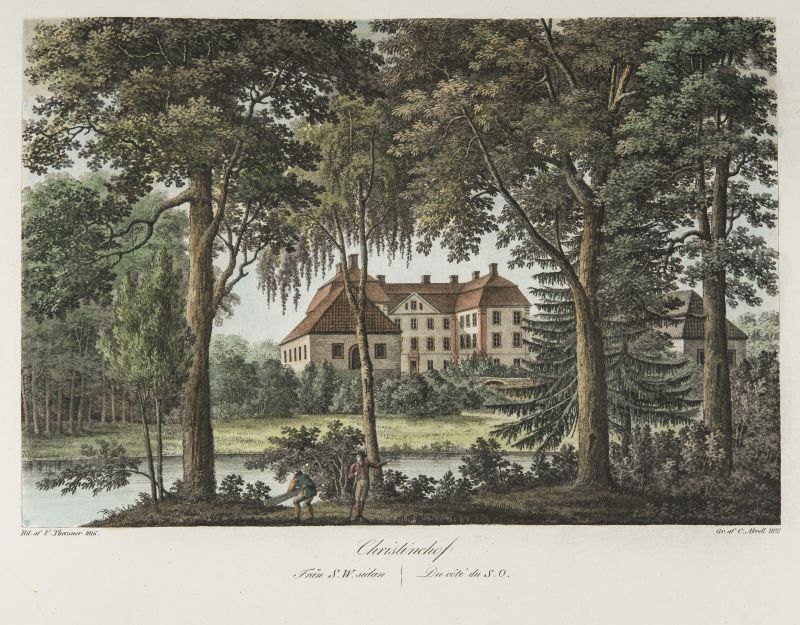 This hand coloured engraving of Christinehof manor house in southernmost Sweden in 1821, gives an interesting view of one of the Piper families’ manor houses and in what sort of country house milieu the family lived their lives over the generations. Despite the sizeable building on three floors built around 1740 for the Countess Christina Piper (1673-1752), this was a summer residence only, which is evident via various documents over the years kept in the present-day archive in the west wing of this house. A few objects linked to embroidery were also listed among the possessions of this house in the 1851 estate inventory. (Courtesy: Lund University Library, Sweden. alvin-record: 183385. Engraver: Carl Fredrik Akrell & illustrator Ulrik Thersner. Public Domain).
This hand coloured engraving of Christinehof manor house in southernmost Sweden in 1821, gives an interesting view of one of the Piper families’ manor houses and in what sort of country house milieu the family lived their lives over the generations. Despite the sizeable building on three floors built around 1740 for the Countess Christina Piper (1673-1752), this was a summer residence only, which is evident via various documents over the years kept in the present-day archive in the west wing of this house. A few objects linked to embroidery were also listed among the possessions of this house in the 1851 estate inventory. (Courtesy: Lund University Library, Sweden. alvin-record: 183385. Engraver: Carl Fredrik Akrell & illustrator Ulrik Thersner. Public Domain).The estate inventories looked at in detail for this essay, listed objects from the Piper family home in Stockholm as well as the manor houses Krageholm and Christinehof in southernmost Sweden, which according to the rules of inheritance of the estate in tail – a document which had been set up by Christina Piper in 1747 – were occupied at various periods over year in the first half of the 19th century. In these domestic spheres, embroidery and other female handicrafts seem to have been part of everyday life over the generations. Due to the aristocratic household’s high standard of living, such occupations for the lady of the house could include silk embroidery for decorative purposes, canvas woollen work for upholstering of chairs, stools and fire screens, marking of linen with additional thread-drawn stitching (probably assisted by female servants) equally as daughters learned various educational needlecraft, which were regarded as desirable or useful for their strata of society. Single pieces or even a complete set of furniture for a room could probably be ordered and delivered ready-made upholstered with canvas embroideries too after each and everyone’s taste, wish of design and financial means – a conclusion drawn from the listed objects in the 1851 document (presented at the end of this essay).
Initially, the estate inventory for Carl Gustaf Piper (1737-1803) in 1803 demonstrates an “ordinary” number of objects related to embroidery, and most of these were sewing tables, other tools, yarn and similar used material for the making of textiles. Judging from this particular written source and their family circumstances, one may assume that most objects made by the lady in the home were intended for personal use, such as needlework decorations on garments, handkerchiefs, or pocketbooks. However, personal items were not included in this sort of legal document. The deceased Carl Gustaf had been married to Hedvig Catharina Ekeblad (1746-1812) since 1769; they had three sons, but no daughters. It may also be noted that a couple of furnishing pieces were listed to have been embroidered at Krageholm Manor House. If these were made by Hedvig Catharina, some earlier female relative or even by a professional embroiderer is unknown.
[Listed objects in translation from the Swedish original. Values excluded. F/III 2].
IN STOCKHOLM
The Count’s Drawing Room
3 small sewing tables of mahogany, placed after each other
2 ditto sewing tables of mahogany
1 sewing table of alder
1 [‘knytbräde’, probably for net making or passementerie] with a mahogany foot.
The Library
2 larger and 2 smaller sewing tables of alder.
The Cabinet
1 oval sewing table with inlaid work and green lacquered top
1 smaller sewing table of mahogany.
The Countess’ Toilette
1 sewing table of mahogany with brass fittings and a lacquered top.
Miscellaneous
1 grey bag with [‘knytning’/net making or passementerie material] and a brass bobbin
1 brown bag with [‘knytning’/net making or passementerie material] and a brass bobbin, with 5 white and 4 green yarn balls
1 brown bag with needles [for net making or passementerie material] and with the belonging box.
KRAGEHOLM MANOR HOUSE
The Countess’ servant room
1 round sewing table.
The Red Drawing room
1 Imperial bed with red embroidered silk curtains and bedcover, added with special woollen curtains.
The Doorway room
1 bed, curtains of linen with embroidered roses.
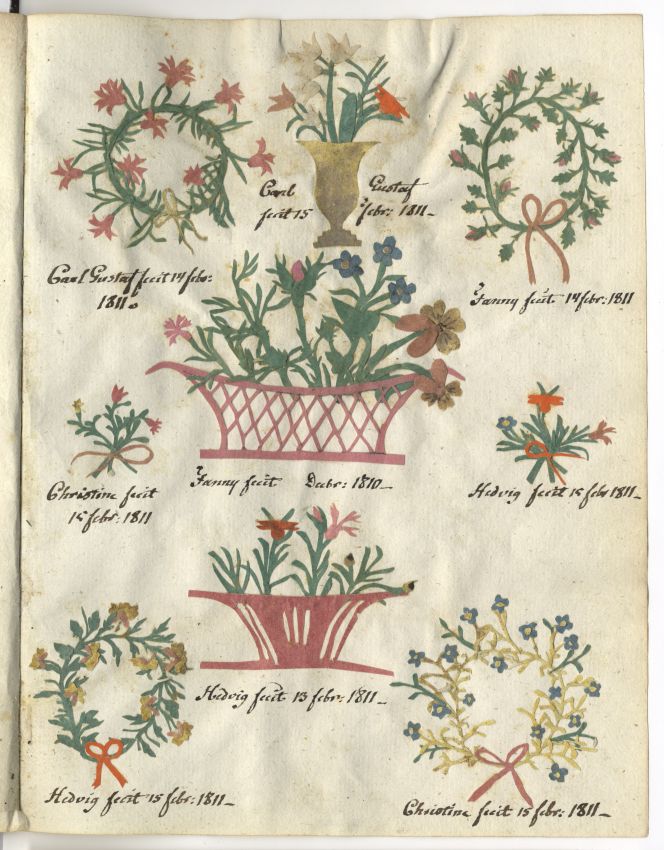 Handicraft and educational craft could take many forms. The uniquely preserved silhouette cutouts dating from 1810-1811 are very similar in design to popular motifs used on contemporary embroidered samplers by girls. This is one of two pages, kept in a volume which originally belonged to Gustaf Piper (1771-1857), the second son of Carl Gustaf Piper discussed in the estate inventory above. Furthermore, it is believed that these finely arranged paper silhouettes were made by three of his children, who at this time were about eight to twelve years old. (Courtesy: Uppsala University Library, Sweden. alvin-record: 99409. Public Domain).
Handicraft and educational craft could take many forms. The uniquely preserved silhouette cutouts dating from 1810-1811 are very similar in design to popular motifs used on contemporary embroidered samplers by girls. This is one of two pages, kept in a volume which originally belonged to Gustaf Piper (1771-1857), the second son of Carl Gustaf Piper discussed in the estate inventory above. Furthermore, it is believed that these finely arranged paper silhouettes were made by three of his children, who at this time were about eight to twelve years old. (Courtesy: Uppsala University Library, Sweden. alvin-record: 99409. Public Domain).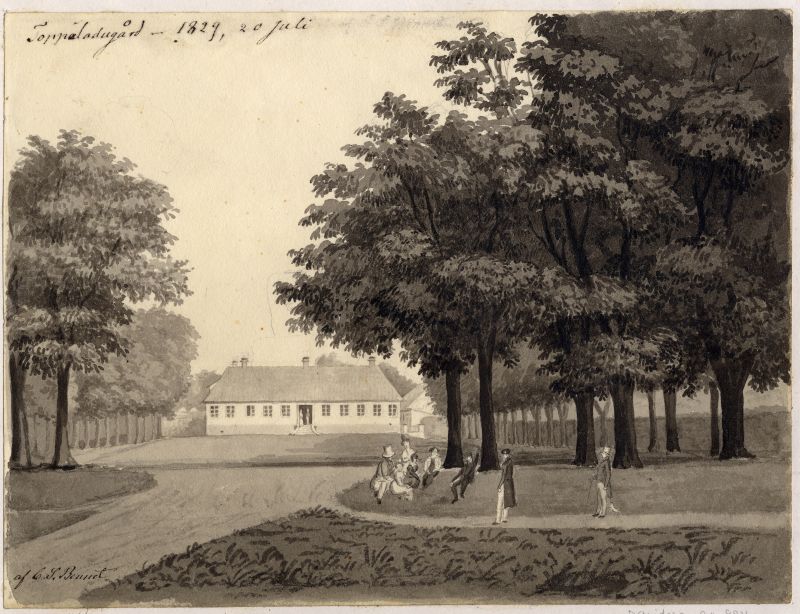 This tinted drawing dating exactly to 20 July in 1829, give a moment in life from one of the Piper family’s former residences, Toppeladugård manor house, in southernmost Sweden (in their ownership since 1712 up to 1791). It was located 40-50 kilometres only from several of the Piper’s other manor houses – Christinehof, Krageholm and Baldringe. The artist Carl Stefan Bennet, part of the then present owner family, illustrated this tranquil garden scene where the fashionable young ladies and gentlemen were seated under the thickly foliaged trees. Even if not reflected here, of understandable reasons gardens had long before this time been regarded as a suitable place for handicraft during pleasant summer days. (Courtesy: Uppsala University Library, Sweden. alvin-record: 85045. Public Domain).
This tinted drawing dating exactly to 20 July in 1829, give a moment in life from one of the Piper family’s former residences, Toppeladugård manor house, in southernmost Sweden (in their ownership since 1712 up to 1791). It was located 40-50 kilometres only from several of the Piper’s other manor houses – Christinehof, Krageholm and Baldringe. The artist Carl Stefan Bennet, part of the then present owner family, illustrated this tranquil garden scene where the fashionable young ladies and gentlemen were seated under the thickly foliaged trees. Even if not reflected here, of understandable reasons gardens had long before this time been regarded as a suitable place for handicraft during pleasant summer days. (Courtesy: Uppsala University Library, Sweden. alvin-record: 85045. Public Domain).The ’tapisserie’ stitching or Berlin wool work became increasingly popular in the period 1830s-1850s, used for comfortable upholstered furniture, carpets, fire screens and so on. It was embroidered on a canvas with cross stitch, gros point or variations of Gobelin stitches, with the surface of the ground canvas fully covered which gave a dense impression, mostly in colourful combinations of flowers and foliage for upholstering. Impressions of painters’ artwork like depiction of a warrior on a horseback, a king, exotic animals or landscape scenes were also favoured on fire screens and other homely objects. Surprisingly few furniture pieces have been preserved with such embroidered padded coverings. Even if evidently valuable armchairs and sofas with various needlework could be provided with protective linen covers when not in use – as noted in the 1851 estate inventory – to save the colours in this display of wealth and up-to-date fashions for parlours and drawing rooms. While most such furnishings from the 1830s-1850s were exposed to light on a daily basis, the colours visibly faded after years of exposure to light. If not before, the once bright-coloured embroideries from the mid-century were often replaced, and upholstering on the mahogany armchairs and sofas was remade in the late 19th century. This during a time when heavy draperies of dark colours decorated with tassels or fringes, together with “Orient” inspired fancy goods and velvet upholstering were preferred. Judging by the document dated 1851 however, colourful embroideries were still very much favoured by the aristocratic wealthy Piper family at this period.
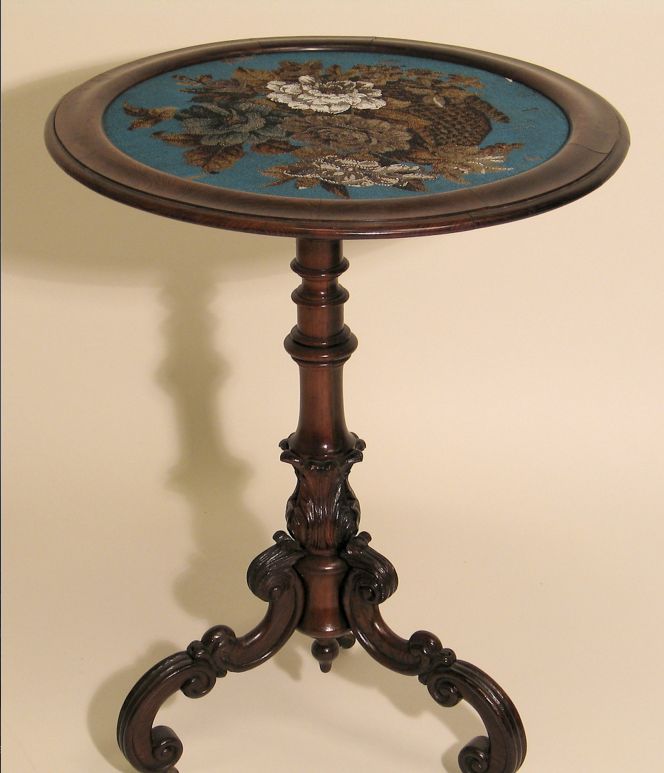 This round walnut table with its embroidered flower arrangement dating circa 1850 is a good comparison to the listed ‘1 table of mahogany, round with embroidery’ in the estate inventory of 1851, kept in the parlour of the Piper family’s Stockholm home. (Courtesy: The Nordic Museum, Sweden. No. NM.0117367. Public Domain).
This round walnut table with its embroidered flower arrangement dating circa 1850 is a good comparison to the listed ‘1 table of mahogany, round with embroidery’ in the estate inventory of 1851, kept in the parlour of the Piper family’s Stockholm home. (Courtesy: The Nordic Museum, Sweden. No. NM.0117367. Public Domain).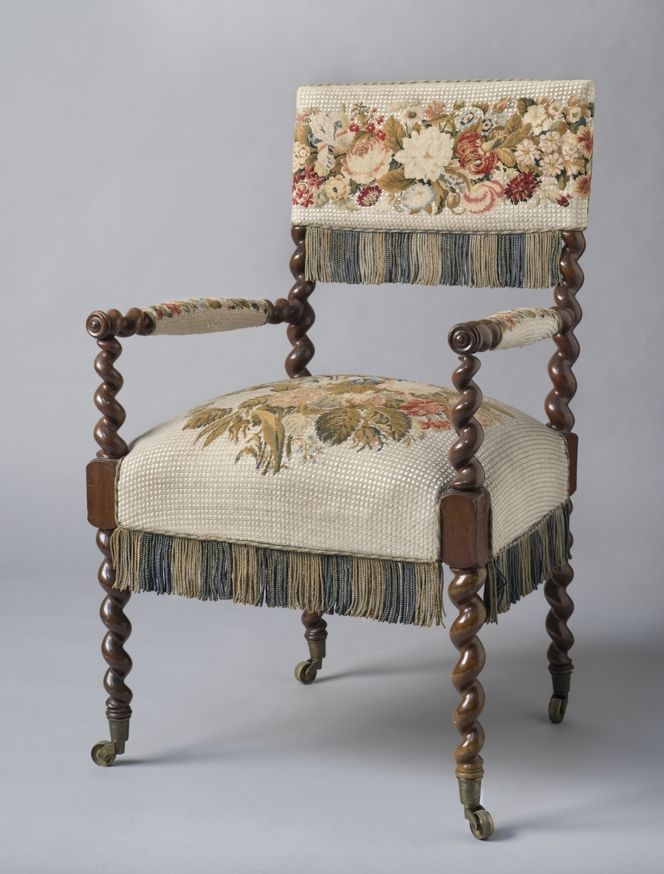 A second comparison is this well-preserved mahogany armchair with its original upholstering from the 1830s, which at the time was part of the interior furnishings at Salsta castle circa 90 kilometres north of Stockholm. The ground was stitched in white silk, whilst wool in a multitude of colours was used for the flower designs in gros point stitches. A two-coloured silk fringe further decorates the armchair. Interestingly, the 1851 estate inventory of the Piper family, listed several mahogany armchairs with embroidery – see below. (Courtesy: The Nordic Museum, Sweden. No. NM.0328347. Public Domain).
A second comparison is this well-preserved mahogany armchair with its original upholstering from the 1830s, which at the time was part of the interior furnishings at Salsta castle circa 90 kilometres north of Stockholm. The ground was stitched in white silk, whilst wool in a multitude of colours was used for the flower designs in gros point stitches. A two-coloured silk fringe further decorates the armchair. Interestingly, the 1851 estate inventory of the Piper family, listed several mahogany armchairs with embroidery – see below. (Courtesy: The Nordic Museum, Sweden. No. NM.0328347. Public Domain).The estate inventory after Carl Claes Piper (1770-1850) in 1851, Carl Gustaf Piper’s oldest son, who passed away almost 50 years after his father (see 1803 document above). Carl Claes had been married to Eva Maria Ruuth (1786-1842), who already had passed away some years earlier. This extensive legal paper includes an extraordinary number of objects linked to embroidery. A probable explanation of the greater interest in handicraft/traces of such objects may be found in that the couple had two daughters who lived to adulthood and both being children and young women in the 1820s to 1830s (in a period when the so-called Berlin wool work and similar styled upholstering decorations increased in popularity). Their names and life span were: Hedvig Elisabet Maria Amalia Piper (1808-1886) and Sofia Lovisa Augusta Piper (1809-1884). Other female relatives and servants could naturally also have been involved in this domestic sphere of textile activity. As already reflected upon, judging by the large number of the extravagant sofas, armchairs, chairs, stools and other pieces with upholstered embroidered covers in the Parlour, there is a likelihood that these particular needlework were professionally made and the mahogany furniture was already upholstered when purchased by the family.
This essay will conclude with the listed objects in translation from the Swedish original of the 1851 estate inventory [F/IV 1, values excluded]. The word ‘tapisserie’ is translated to ‘embroidery’, most likely a wool or silk embroidery on canvas, which covered the whole surface in various flower combinations, as described and illustrated above. For bed linen and bed curtains, other stitchings were used, and in some cases, they were noted in the document.
IN STOCKHOLM
The Drawing room
3 sofa cushions of embroidery | 1 carpet of embroidery | 1 ditto, red and green with flowers.
The Parlour
1 sofa, 8 armchairs, 10 smaller armchairs and 6 low stools of mahogany, upholstered with embroidery together with covers made of blue linen | 1 sofa of mahogany, upholstered with yellow silk fabric and embroidery | 1 easy chair of mahogany, upholstered with embroidery together with 2 cushions |
2 armchairs of oak and walnut, upholstered with embroidery | 2 chairs with high back of mahogany, upholstered with embroidery | 4 chairs of mahogany, upholstered with embroidery, together with blue covers | 1 table of mahogany, round with embroidery | 1 table with gilded foot, upholstered with embroidery | 5 stools, upholstered with embroidery | 6 cushions, upholstered with embroidery | 1 fire screen in 3 sections, of black wood with embroidery | 1 screen, gilded with embroidery | 1 ditto of mahogany with ditto.
The Cabinet
1 chair of mahogany, with high arm, upholstered with embroidered woollen fabric | 1 chair of yellow stained birch, with embroidery | 1 fire screen made of black wood, with tapestry under glass.
The Toilette
1 sewing table of birch.
His Excellence’s outward looking room
1 writing chair of oak, upholstered with morocco leather and embroidery | 1 screen of embroidery, in a black frame | 1 foot stool, upholstered with embroidery.
His Excellence’s inner room
1 toilet chair of black stained wood, with embroidery | 3 cushions with embroidery.
The Store room
1 carpet of embroidery, green ground with yellow, red and black | 2 ditto, black ground with yellow and blue | 1 ditto, blue ground with black border and raised flowers | 1 ditto, grey ground, multicoloured | 1 ditto, blue and yellow, with black velvet | 1 ditto, in red, white and green with black velvet | Embroidery covers for 4 chairs and 2 chair backs | Ditto for 4 chair cushions.
The Attic
1 writing chair made of mahogany with embroidery | 1 sewing table | 1 foot for a sewing table | 1 fire screen made of mahogany with embroidery.
Miscellaneous
1 sewing box | 2 baskets, upholstered with embroidery | 2 pin cushions | 2 reels | 1 reel with accessories | 1 embroidery frame | 1 quilting frame and 1 embroidery frame.
KRAGEHOLM MANOR HOUSE
The Parlour
1 easy chair with horsehair mattress, upholstered seat, together with 3 horsehair pads upholstered with embroidery | 1 sewing table of mahogany | 1 ditto of stained birch | 1 fire screen of embroidery in a black frame.
The Divan room
1 divan, with 5 embroidered cushions.
The Cabinet
1 sewing table of juniper wood.
Room No. 1
3 horsehair cushions, upholstered with embroidery.
Room No. 2
1 sewing table of mahogany, with a tope of lacquered thin sheet-metal.
Bedding, Room No. 12
1 bedcover, embroidered.
Linen, Fabrics and Yarn
4 pillow cases of fine linen, with drawn-thread work and decorations | 6 ditto ditto, embroidered | 6 ditto ditto with drawn-thread work | 2 ditto ditto, embroidered | 6 ditto ditto with drawn-thread work | 6 ditto ditto with embroidery | 6 ditto ditto with drawn-thread work, decorations and embroidery | 7 ditto ditto with drawn-thread work.
Miscellaneous
3 sewing frames | 2 ditto smaller | 1 quilting frame | 1 sewing pad and 2 work baskets.
CHRISTINEHOF MANOR HOUSE
The Red Drawing Room
1 fire screen of birch with embroidery.
Miscellaneous
1 quilting frame.
……………………………………………………………………………………………………………
Sources:
- Christinehof Manor House, Sweden (research visits: 1990 to 2016).
- Hansen, Viveka, Inventariüm uppå meübler och allehanda hüüsgeråd vid Christinehofs Herregård upprättade åhr 1758, Piperska Handlingar No. 2, London & Whitby 2004.
- Hansen, Viveka, Katalog över Högestads & Christinehofs Fideikommiss, Historiska Arkiv, Piperska Handlingar No. 3, London & Christinehof 2016.
- Historical Archive of Högestad and Christinehof, Sweden (Piper Family Archive: F/I a 3,1 Christina Piper’s Estate in tail letter. | F/III 2 & F/IV 1: estate inventories).
- Kjellberg, Sven T., Slott och Herresäten i Sverige: Skåne, (three volumes) Malmö 1966.
- Mannerstråle, Carl-Filip, Nya huset i Andrarum Anno 1741, Piperska Handlingar No. 1, Christinehof 1991.
- Nylén, Anna-Maja, Hemslöjd: Den svenska hemslöjden fram till 1800-talets slut, Lund 1969 (Embroidery: pp. 202-272).
Essays
The iTEXTILIS is a division of The IK Workshop Society – a global and unique forum for all those interested in Natural & Cultural History.
Open Access Essays by Textile Historian Viveka Hansen
Textile historian Viveka Hansen offers a collection of open-access essays, published under Creative Commons licenses and freely available to all. These essays weave together her latest research, previously published monographs, and earlier projects dating back to the late 1980s. Some essays include rare archival material — originally published in other languages — now translated into English for the first time. These texts reveal little-known aspects of textile history, previously accessible mainly to audiences in Northern Europe. Hansen’s work spans a rich range of topics: the global textile trade, material culture, cloth manufacturing, fashion history, natural dyeing techniques, and the fascinating world of early travelling naturalists — notably the “Linnaean network” — all examined through a global historical lens.
Help secure the future of open access at iTEXTILIS essays! Your donation will keep knowledge open, connected, and growing on this textile history resource.
been copied to your clipboard




– a truly European organisation since 1988
Legal issues | Forget me | and much more...
You are welcome to use the information and knowledge from
The IK Workshop Society, as long as you follow a few simple rules.
LEARN MORE & I AGREE







